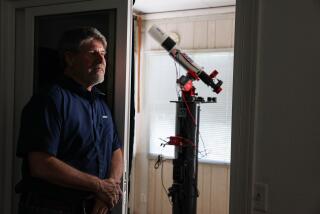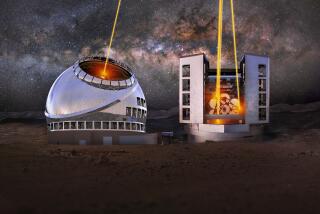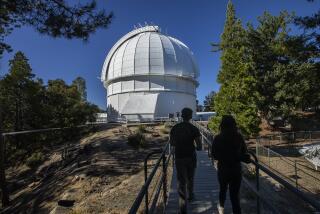A Whole Other Cosmos
Thereâs nothing like quietly contemplating the sky on a clear, moonless night to make us feel we can touch the cosmos in its entirety -- the bright canopy of stars, the ever-shifting play of planets, the vast, cold silence of infinite space.
How little we know.
All this glory is but the barest glimpse of whatâs actually out there. Tales of extreme violence and profound mystery stream at us from every corner of the cosmos, and yet weâre constrained to peering through the tiniest keyhole, seeing only the thin band that beams in visible light. Until very recently, even astronomers, who see nearly the entire electromagnetic spectrum, from radio to gamma rays, have been able to tune in to only the barest trickle from the flood of news.
In the last few years, however, new instruments have begun painting a far more vibrant image of the universe. The celestial story now unfolding has as much in common with the picture of decades past as a Technicolor, Dolby Digital surround-sound production has with a grainy silent film.
Consider: In the last year alone, a satellite tuned to faint microwaves still glowing from the Big Bang took a picture of the quantum mechanical quivers in the newborn universe that pulled matter into what eventually became galaxies, stars, and ultimately, us. The picture pinned down the age of the universe precisely -- 13.7 billion years -- and confirmed its exact mix of ingredients. The same astonishing image suggested that the fires of the first stars electrified the skies 200 million years after the Big Bang -- much earlier than most astronomers predicted.
Meanwhile, X-ray telescopes have been finding black holes -- objects of such concentrated energy and warped space that they trap even light -- virtually everywhere theyâve looked. One satellite alone found 1,500 supersized holes feeding on surrounding gas and stars in just a small patch of sky. Other telescopes found a whole new species of midsized models previously unknown to exist.
âFar more black holes are lurking out there than anyone thought,â said Sonoma State University astrophysicist Lynn Cominsky. âIf you look at the universe in visible light, itâs pretty calm. But in X-rays and gamma rays, itâs very violent.â
From the infrared end of the spectrum comes UCLA astronomer Andrea Ghezâs discovery that the supermassive black hole in the middle of the Milky Way is flinging a star around at 3% of the speed of light as if it were a pebble from a slingshot.
And the adventure has barely begun. On Aug. 23, NASA is set to launch the last of its four âgreat observatories,â grand telescopes in the sky, each tuned to a particular swath of the electromagnetic spectrum. While Hubble, Chandra and the now defunct Compton telescopes looked at visible light, X-rays and gamma-rays, respectively, the new infrared telescope will allow astronomers to peer through the fog that shrouds the births of stars and planets.
Following not far behind them are two more âGreat Einsteinâ observatories. Both involve arrays of telescopes flying in formation like well-practiced flocks of birds, in one case effectively creating an observatory millions of kilometers across.
Almost every month, new ground-based telescopes open their eyes, and new special-purpose explorers take off for the clearer skies of space. Some, like the Sloan Digital Sky Survey, are mapping much of the sky in great detail, pinning down the location of galaxies, stars and distant quasars to create a three-dimensional image of its large-scale structure. Others, like Hubble, often go deep and narrow, taking what amounts to a core sample of the universe.
âItâs amazing to think about how much this has developed since I was in graduate school,â said Michael Jura, a 55-year-old astronomer at UCLA. The laws of physics havenât changed, âbut the consequences are enormously greater than people imagined,â he added.
The vast expansion of the spectrum of the possible puts scientists on the brink of being able to answer some of the thorniest questions ever posed: How do solar systems form? How did matter come into being? Does space really crinkle, and time really stop, at the horizon of a black hole?
As Einstein once put it, the most incomprehensible thing about the universe may well be that itâs comprehensible at all. Certainly, the recent unveilings -- and those to come -- have been made possible not only by leaps in technology but also by a willingness to follow the often outlandish lead of theoretical predictions.
In fact, one of the niftiest new tools astronomers use to see deep into space comes straight out of an outrageous suggestion by Einstein. His theory of general relativity implied that large concentrations of mass should bend light just as glass does, forming âgravity lenses.â
The first such lens was discovered in 1979, and more than 100 have been found since. Today, they are regularly put to use as natural âtelescopes,â enabling astronomers to find everything from previously unseen distant galaxies to concentrated globs of dark matter.
At present, most of the eye-opening discoveries stem from improved techniques for tuning into the electromagnetic spectrum, which ranges from gamma rays smaller than atoms to radio waves bigger than mountains. (The rainbow of visible light our eyes detect is a narrow ribbon midway through the spectrum.)
The universe broadcasts in all these bands, yet very little gets through. X-rays, for example, can easily see through Lois Laneâs clothes but can no more penetrate our atmosphere than they could a sheet of lead. And violent objects like collapsing stars and black holes broadcast their presence almost exclusively in X-rays.
Some infrared light does get through to Earth, but only in patches, with a lot of interference from sources like infrared telescopes themselves. Everything above absolute zero temperature radiates in infrared -- including air and icebergs.
Thus, even astronomers like Ghez who already observe in infrared from the ground are excited about NASAâs Space Infrared Telescope Facility, or SIRTF, which will be chilled to close to absolute zero. That, plus state-of-the-art detectors, means that SIRTF will be a million times more sensitive than previous infrared missions.
(In all respects, SIRTF is a very Southern California enterprise. The SIRTF Science Center, which evaluates proposals for observing time and processes data, is based at Caltech. Two of the original science team members -- Jura and Ned Wright -- are professors at UCLA.)
Infrared astronomy is particularly effective at looking back at the earliest moments of time. In an expanding universe, light that began its multibillion-year journey as X-rays would have by now become almost entirely stretched into longer wavelength infrared. Infrared also slips through the thick, dark dust that clouds the birth of stars. Astronomers donât even know whether stars are typically born in splendid isolation, like our sun, or as twins, which seem to be far more common.
And itâs the only way to study the cool dust itself, critical to understanding how planetary systems form. (Planets are little more than clumps of dust left over from coalescing stars.)
It would be misleading to credit space-based astronomy with all the big advances. At the Keck telescopes in Hawaii, Ghez, for example, keeps track of stars speed-racing around the Milky Wayâs center. Their vision was dramatically improved when they were fitted with âadaptive opticsâ that can clear up atmospheric blurring using mirrors that flex thousands of times per second, effectively taking the twinkle out of starlight.
Another breakthrough is the increasing use of interferometry -- the combining of waves from many different telescopes, often widely spaced, to produce a single, vastly magnified image. Long a staple of radio astronomy, itâs exceedingly difficult with short-wavelength light. Still, most major observatories are working on it, and recently the twin Keck telescopes successfully combined infrared light to bring into focus a swirling disk of dust around a very young star.
One result of this vastly expanded view -- the âpanchromatic approachâ as Caltech astrophysicist Shri Kulkarni calls it -- has brought about a change in the culture of astronomy itself. A single astronomer can now make use of data from satellites in space, mirrors on mountaintops and radio arrays in deserts. âPeople used to say, âIâm an X-ray astronomer,â â Cominsky said. âNow you get people saying, âI look at active galactic [centers].â
UCLA astronomer Mark Morris, for example, studies the Milky Wayâs turbulent core -- a place that screams in every part of the spectrum -- using radio, infrared and X-rays. âYou really constrain yourself too much if you look at a single wavelength,â he said.
Astronomers are no longer constrained by the clock, either.
âWe make an observation, we put it on the Internet,â Kulkarni said. âThen we go to sleep, then someone in Japan picks it up. Itâs not just multi-wavelength. Itâs globalization.â
There is a downside to this rain of riches, Cominsky admits. âToo much data, too little time. Weâre looking at things faster than we can assimilate them.â
The good news is that astronomers are working as very large arrays themselves, combining instruments and expertise.
A case in point is the teamwork that allowed astrophysicists last year finally to identify the source of gamma ray bursts that can spit out a million times the combined energy of all the stars in the Milky Way in a fraction of a second. The bursts go off like random firecrackers all over the sky, and fade too quickly to follow easily.
Instant alerts by gamma-ray watchers in space now allow astronomers to trace the visible afterglow that can remain after the burst like the trail of a sparkler. âYouâve got armies of people chasing these things,â Cominsky said. And armies of robotic telescopes that bypass people entirely, taking their data straight to the Internet.
As a result of these coordinated efforts, astronomers are almost certain that the bursts are last gasps coming from the sudden collapse of supermassive stars.
With every juicy discovery, of course, come even juicier new mysteries. The stars that Ghez and colleagues found skimming our galaxyâs central black hole at 9,000 kilometers per second are far too massive to have formed in such a chaotic environment, where the black holeâs huge gravitational tides would tear emerging stars apart. âThereâs no way star formation should be going on there,â Ghez said. And yet, the stars appear far too young to have drifted in from a distant, quieter neighborhood.
And while precision measurements of microwaves from the Big Bang have pinned down the exact proportions of the various ingredients that make up the cosmos, they also left entirely unexplained what these ingredients actually are. Almost nothing is known about the 23% that is âdark matter;â less still about the 73% that goes by the name âdark energyâ -- an even stranger brand of stuff that is thought to be some intrinsic property of the vacuum that exerts a repulsive, antigravity-like force.
Answering these questions may require solutions that go far beyond anything the electromagnetic spectrum has to offer.
Recently, for example, a radically new kind of observatory has begun to tune into âgravitational waves,â another prediction of Einsteinâs relativity theory. These disturbances in space-time itself are exceedingly difficult to detect because they only barely affect matter. Even the tsunami set off by distant colliding black holes would wash up on Earthâs shores as barely detectable ripples. To sense them, two four-kilometer-long laser beams are strung like spider silk at right angles between nearly perfect mirrors, poised to catch the smallest perturbation.
With two virtually identical observatories on opposite sides of the country, LIGO (Laser Interferometer Gravitational Wave Observatory) can rule out many of the local jitters (anything from a passing truck to a tiny seismic shift) that might masquerade as undulating space.
The real excitement, however, focuses on LIGOâs successor, LISA, for Laser Interferometer Space Antenna -- one of two Great Einstein Observatories already in the works. LISAâs three satellites will comprise an orbiting, triangular observatory with a 5-million-kilometer base. That makes it large enough to detect the lingering thunderclap of long-period waves set off when an ordinary black hole falls into the grasp of a supermassive black hole millions of times the mass of the sun -- mergers and acquisitions on a cosmic scale.
Following such violent events, LISA could sense space crumpling and time freezing. âGravity wave astronomy has become a real subject,â Kulkarni said. âIn less than 10 years, we may be actually seeing the birth of black holes.â
And because everything is transparent to gravity waves, LISA has the potential to peer all the way back to the Big Bang. If so, it might be able to watch matter coming into being from the vacuum of empty space, or see how three dimensions of space evolved out of a cosmos with many more dimensions. Both LISA and the second Great Einstein Observatory -- a flying array of four X-ray telescopes, Constellation X -- are on track for launch by 2010 or 2011.
Other astronomers, meanwhile, are turning to ghostly particles called neutrinos to see deep inside exotic objects like exploding stars.
Because neutrinos barely notice either light or matter (trillions pass through your body every second), they can travel unhindered from almost anywhere in the cosmos. When Supernova 1987A exploded, neutrinos arrived in detectors on Earth many hours before astronomers saw the light.
A neutrino âtelescopeâ aptly named Ice Cube will soon string a cubic kilometer of South Pole ice with detectors, looking for neutrinos from similar cosmic-scale catastrophes.
As our keyhole expands, the universe, as Einstein put it, âbeckons like a liberationâ from the other side. Of course, as Alice learned, you never know what youâll find when you slip through a keyhole.






